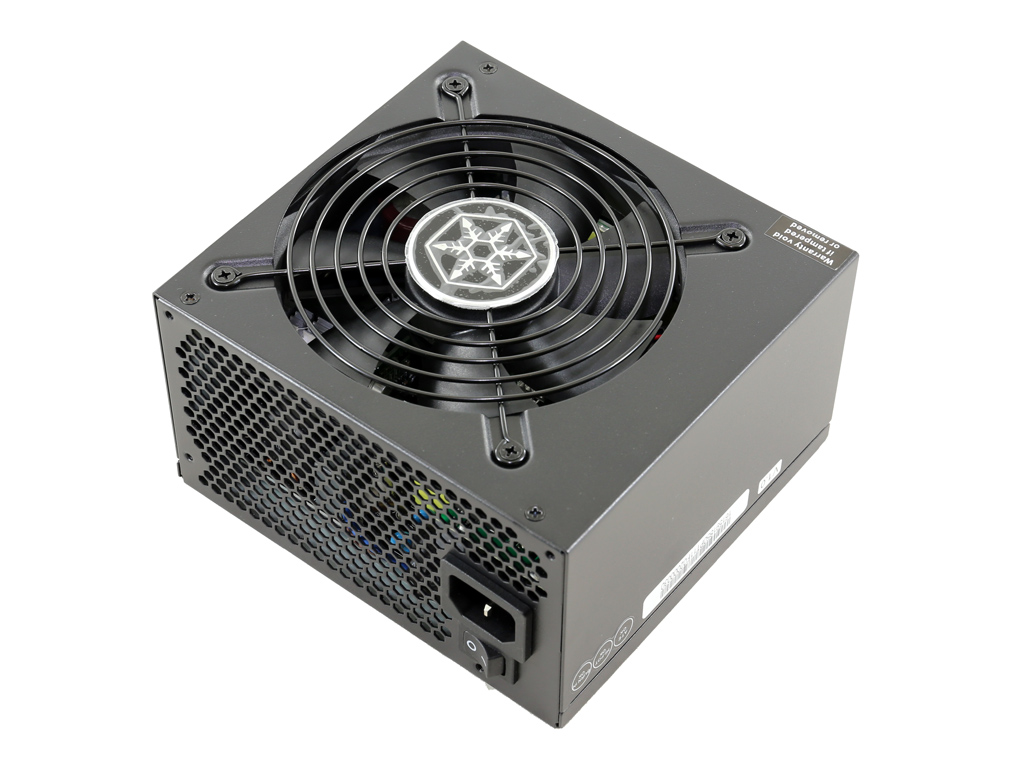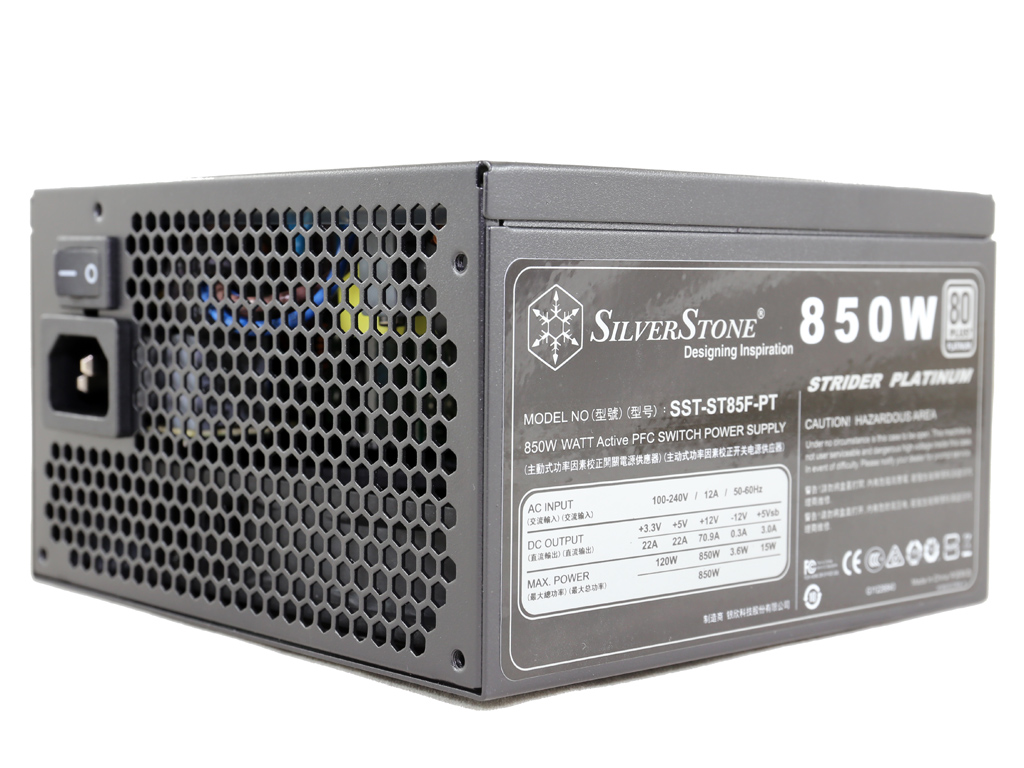Early Verdict
The ST85F-PT is the most compact 850 W fully-modular and Platinum PSU that money can buy today. If you need a very small in dimensions, but powerful PSU then this product is a one way road. It is a great shame though that it is affected by the inaccurate power good signal disease.
Pros
- +
Full power at 46 °C
- +
Efficient
- +
Ripple suppression
- +
Silent
- +
Compact dimensions
- +
Quality electrolytic caps
- +
FDB fan
- +
Semi-passive operation
- +
Fully modular
Cons
- -
Tough competition in this price range
- -
Performance of the 3.3V rail
- -
No fan-test option
- -
Hold-up time
- -
4x PCIe connectors
- -
Semi-passive operation can lead to OTP's triggering in some extreme case scenarios
- -
High inrush current
Why you can trust Tom's Hardware
SilverStone ST85F-PT Power Supply Review
Previously, SilverStone's Strider Platinum family consisted of four members with capacities ranging from 550 to 850 W. However, two more units were recently added, rated for 1 kW and 1.2 kW. This makes the line more complete since it covers everything from mainstream to high-end PCs. The two higher-capacity models are larger than the others, measuring 18 cm deep, though their footprint is still reasonable.
SilverStone is one of the few companies that provides a power density, or watt per liter, score for each of its products. For the Strider Platinum family, the ST1200-PT achieves the highest score with its 517 W per liter rating. Second-place goes to the ST85F-PT (471 W per liter) thanks to its shallow depth of only 140 mm. We already reviewed the ST75F-PT, and now the time has come for us to look at the ST85F-PT. According to SilverStone, this is the world's smallest (physically), fully modular ATX PSU with 850 W capacity and 80 PLUS Platinum efficiency.

The ST85F-PT is based on a Sirfa/High Power platform. Rarely does SilverStone partner with an OEM other than Enhance Electronics, and we aren't huge fans of Sirfa's designs. Moreover, the OEM is mostly known for budget-oriented products.
Due to the power supply's compact size, the ST85F-PT uses a smaller 120 mm fan. Usually that translates into more noise due to the faster-spinning blades. Fortunately, in this case, the PSU is supported by a semi-passive mode that outputs zero noise under light loads.
Specifications

This product's main features are 80 PLUS Platinum efficiency, a 40 ℃ temperature rating for continuous full-power delivery, the single +12V rail, a fully modular design, and the 120 mm FDB fan.
The ST85F-PT is stocked with every protection feature you could want. Only OCP is missing, and that's meaningless in an 850 W PSU with one +12V rail. Finally, SilverStone increased its warranty to five years, which is pretty long. Still, the warranty falls short of Corsair's and EVGA's 10-year coverage in this price segment. Given that this product has to fight with the EVGA G2/P2 models and Corsair RMx ones, we believe that SilverStone should make the warranty last at least seven years.
| Rail | 3.3V | 5V | 12V | 5VSB | -12V | |
|---|---|---|---|---|---|---|
| Max. Power | Amps | 22 | 22 | 70.83 | 3 | 0.3 |
| Watts | 120 | 850 | 15 | 3.6 | ||
| Total Max. Power (W) | 850 |
The single +12V rail can deliver the PSU's full power alone, typical of every modern PSU that features DC-DC converters for generating the minor rails. Speaking of the minor rails, their output is strong enough to support an enthusiast-class system; the same applies to the 5VSB rail. As for the -12V rail, we don't really care about it. The newest ATX specification states that it's no longer required, so PSU manufacturers should get rid of it as soon as possible.
Cables And Connectors
| Modular Cables | |||
|---|---|---|---|
| Description | Cable Count | Gauge | Connector Count (Total) |
| ATX connector 20+4 pin (560 mm) | 1 | 18 AWG | 1 |
| 4+4 pin EPS12V (750 mm) | 1 | 18 AWG | 1 |
| 4+4 pin EPS12V (550 mm) | 1 | 18 AWG | 1 |
| 6+2 pin PCIe (550 mm) | 4 | 18 AWG | 4 |
| SATA (600 mm+150 mm+150 mm+150 mm) | 3 | 18 AWG | 12 |
| Four-pin Molex (600 mm+150 mm+150 mm) | 1 | 18 AWG | 3 |
| FDD Adapter (+100 mm) | 1 | 22 AWG | 1 |
The number of PCIe connectors is low for a 850 W PSU, though at least there are two EPS connectors available at the same time. The ST75F-PT only has one EPS connector, so if you need two of them, the ST85F-PT is a better fit. Moreover, the ST85F-PT has 12 SATA connectors, four more than the 750 W model. Strangely enough, though, it only has three peripheral four-pin Molex connectors, while the lower-capacity model has six. We also noticed another major difference between the 750 W and 850 W Strider Platinum units: the former has two Berg connectors fixed on the native cables, while the latter has one provided through an adapter. Of course, we prefer the adapter since only a handful of users will actually use a floppy connector. SilverStone probably noticed this shortcoming in the ST750F-PT and decided to fix it for the ST85F-PT.
All of the cables consist of 18-gauge wires, which are recommended by the ATX spec.
Power Distribution
Since this PSU features a single +12V rail, we do not have anything to say about its power distribution.
MORE: Best Power Supplies
MORE: Power Supplies 101
MORE: How We Test Power Supplies
MORE: Picking The Right Power Supply: What You Should Know
MORE: All Power Supply Content
Current page: SilverStone ST85F-PT Power Supply Review
Next Page Packaging, Contents, Exterior, And Cabling
Aris Mpitziopoulos is a contributing editor at Tom's Hardware, covering PSUs.
-
panathas I don't understand, first you said: "On the other hand, it doesn't have an issue with inaccurate power-good signals that last longer than the corresponding hold-up time" and your last words were: "It is a great shame though that it is affected by the inaccurate power good signal disease". Which one is true? Also in the CONS section you only mentioned the Hold-up time and not the power good signal.Reply -
turkey3_scratch Reply18699506 said:I don't understand, first you said: "On the other hand, it doesn't have an issue with inaccurate power-good signals that last longer than the corresponding hold-up time" and your last words were: "It is a great shame though that it is affected by the inaccurate power good signal disease". Which one is true? Also in the CONS section you only mentioned the Hold-up time and not the power good signal.
First one must have been an mistake since it does drop the PWR_OK after the voltages are already out of spec. -
Aris_Mp Yes something was way out in this phrase. It is fixed now.Reply
This PSU is affected by a fake power good signal, which usually is the case in Sirfa's platform.
In the cons section. Sometimes I don't mention the fake power good signal, when the hold-up time is already too low. But I will make sure that I do from now on. -
Virtual_Singularity ty for the review. So, I know it's kind of not really adequate for comparison considering the watt difference. But, looking at the performance of that last Lian Li sfx reviewed, and this thing, still must say that LL didn't do so badly, though they could really help things if they extended that warranty by at least a year or more.Reply -
Co BIY I think the exterior photos need something for scale. Full-size black boxes and tiny high efficiency black boxes look the same size on a screen without something for scale.Reply
No comment on vacant modular socket plugs. First time I've seen that. Also the copper bars aren't a feature I've seen commented on before.